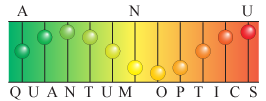Quantum Memory
Normal, classical optical signals are carried by changing the amplitude of the light and the signal may be detected simply with a photodetector. In this case a piece of paper, or a computer hard-drive could be used to store the information carried on the light. You can use the stored data to drive a laser and recreate the amplitude signal with which you started.
In a quantum information scenario, however, information may be encoded on the amplitude and phase of the light. With weak, quantum limited signals, Heisenberg's uncertainty principle means that you may not simultaneously measure the amplitude and phase of your light without disturbing your signals. To store quantum information, you need to actually store the light itself without measuring it. If you measure it, the information will be lost.
The goal of our work is to map states of light into the excitation of clouds of atoms. When the light is absorbed into the atoms, they can store the full quantum information of the input light. With a few tricks, it is possible to un-absorb the light at a later time. To do this we use a technique known as the Gradient Echo Memory (GEM).
Efficiency and Storage time
Using laser cooled atoms we can increase the storage time of the memory and maintain our efficiency. Figure 7 shows a comparison of our experiment to other techniques around the world. Full details can be found in Optica 3, 100 (2016).
 {.figure-img .img-fluid}
{.figure-img .img-fluid}
Stationary light
A quantum memory, as desccribed above, stores the information encoded in the light, but when stored, there is no light in the memory. Stationary light, on the other hand, is light that is bright but not moving. It is stored as a stationary cloud of light in the atomic ensemble. You can read a non-technical description of this experiment here.
Selected publications
- Multiparameter optimisation of a magneto-optical trap using deep learning Nature Communications 9, 4360 (2018)
- Dynamical observations of self-stabilizing stationary light: Nature Physics 13, 68–73 (2017)
- Highly efficient optical quantum memory with long coherence time in cold atoms: Optica 3, 100 (2016).
- High efficiency coherent optical memory with warm rubidium vapour: Nature Communications, 2,174 (2011)
- Memory-enhanced noiseless cross-phase modulation: Nature Light Science and Applications, 1, e40 (2012)
- Unconditional room-temperature quantum memory: Nature Physics, 7, 794 (2011)
- A coherent optical pulse sequencer for quantum applications: Nature, 461, 241-245 (2009)
